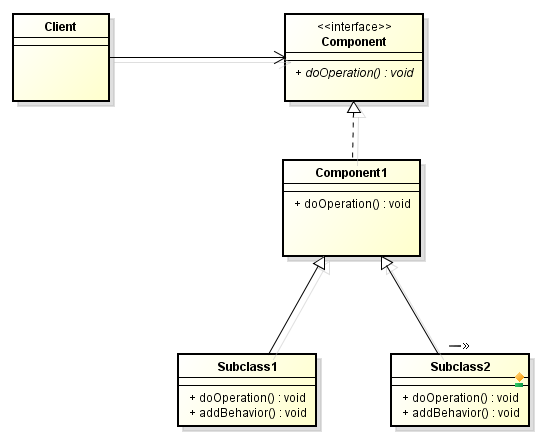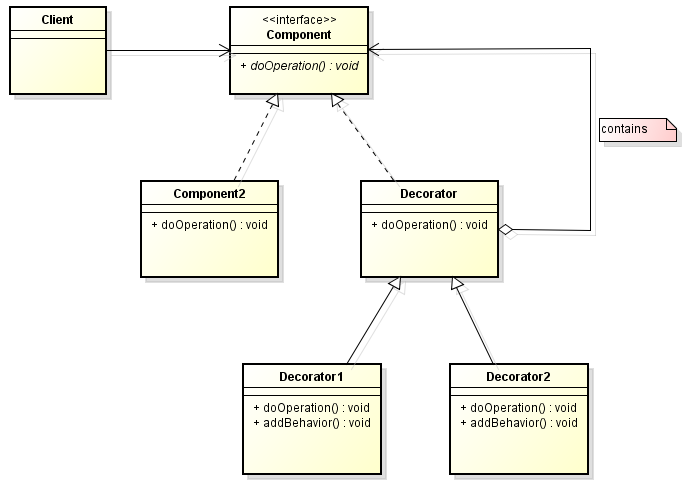In this article, we will learn how to use Decorator pattern. Let’s get started.
Table of contents
- Given Problem
- Solution with Decorator Pattern
- When to use
- Code C++/Java
- Benefits & Drawbacks
- Relations with other patterns
- Application & Examples
- Wrapping up
Given Problem

Assuming that we have an interface Component, and the Component1 class that implements the above interface Component. Normally, when we want Component1’s instance do something, we will invoke doOperation() method.
But if we want to add new behavior to doOperation() method of Component1 class, we have to extends Component1 class. Then we have Subclass1 and Subclass2 classes with doOperation(), addBehavior() methods.
doOperation() method of Subclass1 class will still call doOperation() method of the parent class, and then call its addBehavior() method.
We can find some problems here:
-
We are adding new behavior at compile time because with each subclass of Component1 such as
Subclass1orSubclass2, we will have a specific behavior. If we want to have a behavior that is inSubClass1, andSubclass2at run time, a normal way is that we createSubclass3that extends Component1 class. It’s bad idea to do it.So, subclassing is not a flexible way to resolve its problem.
-
With an above problem, when we want to add multiple functionalities, we have to create the amount of subclasses. It produce an explosion of subclasses.
We will have some questions that solve:
- How can responsibilities be added to an object dynamically?
- How can the functionality of an object be extended at run-time?
Solution with Decorator Pattern
To solve these above problems in Given Problem, we will do some following steps:
-
Define separate Decorator objects.
-
Define a class (
Decorator) that maintains a reference to aComponentobject (component) and forwards requests to this component (component.operation()). -
Define subclasses (
Decorator1,…) that implement additional functionality (addBehavior()) to be performed before and/or after forwarding a request.
-
-
Because decorators are transparent enclosures of the decorated component, they can be nested recursively to add an open-ended number of responsibilities. Changing the order of decorators allows adding any combinations of responsibilities.
So, we have class diagram of this pattern:

When to use
- when we want to add new functionalities for objets without utilizing inheritance property. It’s a better approach than adding many subclasses with little variations, it’s also better than adding many properties to a higher level class but because we many wind up with many decorators, consider using the Factory and Builder pattern to return the decorated objects.
Code C++/Java
To refer this pattern’s code, we can read this link.
Benefits & Drawbacks
-
Benefits
-
The decorator pattern can be used to make it possible to extend (decorate) the functionality of a certain object at run time.
-
The decorator pattern is an alternative to subclassing. Subclassing adds behavior at compile time, and the change affects all instances of the origin class.
Decorating can provide new behavior at run time for inidividual objects.
-
Decorator offers a pay-as-you-go approach to add responsibilities. Instead of trying to support all foreseeable features in a complex, customizable class, we can define a simple class and add functionality incrementally with Decorator object.
-
Adheres to Single Responsibility Principle (one functionality per class).
-
-
Drawbacks
-
Decorator can complicate the process of instantiating the component because we not only have to instantiate the component, but wrap it in a number of decorators.
-
It can be complicated to have decorators keep track of other decorators, because to look back into multiple layers of the decorator chain starts to push the decorator pattern beyond its true intent.
-
Looks ugly and complicated because building up our code with multiple layers.
-
Sometimes inflexible with the order of decorating.
For example:
new BufferedReader(new FileReader(new File("f.txt"))); new BufferedReader(new File("f.txt")); // no compile
-
Relations with other patterns
- Composite pattern composes objects into a tree structure.
- Adapter pattern provides an alternative interface for an class or object.
- Bridge pattern lets an abstraction and its implementation vary independently.
- Facade pattern provides an unified interface for objects in a subsystem.
- Flyweight pattern supports large numbers of fine-grained objects efficiently.
- Proxy pattern provides additional functionality when accessing an object.
Application & Examples
-
File I/O of java.util.
FileReader frdr = new FileReader(filename); LineNumberReader lrdr = new LineNumberReader(frdr); -
Java stream.
-
In Java 8, we can use lambda to make it. And we have some funtional interface that supports for this pattern.
- Predicate: and, or, negate.
- Consumer: andThen.
- Function: andThen, compose.
- reduce(BinaryOperator) method builds complete closure.
Wrapping up
-
The key idea in decorator pattern is to work through separate
Decoratorobjects that ‘decorate’ (add responsibilities to) an (already existing) object. -
Decorator pattern could be replaced with functional programming.
Refer:
https://w3sdesign.com/index0100.php#gf
http://www.beabetterdeveloper.com/2013/03/wanna-cache-decorate.html